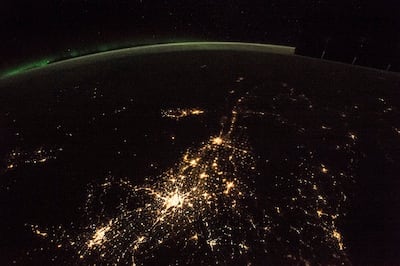Over the past few days, Earth has experienced a substantial solar storm, serving as a vivid reminder of the Sun's profound effect on our planet.
This latest storm created stunning auroras visible far beyond their usual range and disrupted satellites, including Elon Musk’s Starlink fleet.
Northern lights were being reported by residents in North America, India, Tasmania and Europe, with thousands of images posted on social media.
While it was the most intense solar storm to strike Earth in the past two decades, there have been even stronger ones in the past that caused chaos because of infrastructural damage and caused auroras in unusual locations.
The Carrington Event of 1859
The most powerful solar storm on record, the Carrington Event, took place in early September 1859.
An intense white light flare was erupted by the Sun, which was followed by a massive coronal mass ejection, or charged particles, that reached Earth in about 17 hours.
The geomagnetic storm caused spectacular auroras visible as far south as the Caribbean.
Telegraph systems around the world failed, with some operators reporting sparks and fires from their equipment.
This event highlighted the potential for solar activity to disrupt technology and served as an early wake-up call for the field of space weather forecasting.
The event was named after British astronomer Richard Carrington, who was the one to discover the solar flare that caused the storm.
The Quebec blackout of 1989
Another significant solar storm struck in March 1989, causing a massive power cut in Quebec, Canada.
A coronal mass ejection hit the planet, including currents that overwhelmed the province’s power grid.

Quebec was plunged into darkness for more than nine hours, affecting millions of people and causing economic losses that were estimated to be at hundreds of millions of dollars.
The storm also caused minor disruptions in other parts of North America and Europe.
This event showed how vulnerable modern infrastructure can still really be to space weather.
Halloween storms of 2003
The storms started on October 19 in 2003 and peaked around Halloween, earning its name after the celebration.
These storms were caused from several coronal mass ejections rapidly launched from the Sun.

It caused widespread auroras, visible as far south as Texas and Florida, and disrupted satellite communications, GPS systems and power grids.
Planes were rerouted to avoid high radiation levels and astronauts on the International Space Station had to take shelter from increased radiation.
The Bastille Day Event of 2000
The Bastille Day Event, named after the French national holiday on July 14, happened in 2000 and was known to be the most powerful solar storms of the first space era at the time.
A massive solar flare had erupted, followed by a coronal mass ejection, that reached Earth about 24 hours later.
The storm caused intense auroras visible across Europe and North America and temporarily disabled some satellites.
It also disrupted radio communications and GPS signals, causing issues for aviation and maritime navigation.
August 1972 storm
The solar storm of August 1972 took place during a period of heightened solar activity and had significant implications for military and civilian technology.
Between August 2 and August 11, 1972, a series of solar flares and coronal mass ejections bombarded Earth.
The resulting geomagnetic storms disrupted communications and radar systems used during the Vietnam War, leading to a pause in naval operations.
Auroras were observed at unusually low latitudes, and some satellites suffered damage from increased radiation levels.
The New York Railroad storm of 1921
One of the lesser known but highly impactful solar storms happened in May 1921, affecting the north-eastern US and parts of Europe.
A powerful coronal mass ejection struck Earth, causing geomagnetic disturbances.
Telegraph and telephone lines were disrupted, with some stations experiencing fires due to induced electric currents.
It also caused widespread railway signal failures, leading to transport disruptions.











